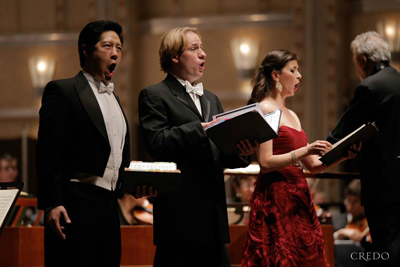by Daniel Hautzinger
Joy, wonderment, thanksgiving, love. These are the feelings Haydn sought to express toward the Divine in The Creation, but they apply equally well to the work itself. Haydn’s bliss and awe in the face of nature, his gratitude for the world, and the love between Adam and Eve are embodied so perfectly in music that an audience can’t help but be overwhelmed by them as well. It’s impossible to come away from a performance of The Creation without a happy heart.
This was certainly true on July 19th in Severance Hall, when John Nelson conducted the Credo Festival Orchestra and Chorus in a rousing performance of The Creation with soprano Lisette Oropesa, tenor John Tessier and bass Adam Lau.
The oratorio is in three parts. The first describes the creation of the natural world in the first four days, while the second depicts the creation of living creatures and man in the fifth and sixth days, both through narration by the angels Gabriel, Uriel, and Raphael. The third section follows Adam and Eve in their first few hours in the Garden of Eden as they praise God and rejoice in each other.
The libretto comes from the Books of Genesis and Psalms as well as from John Milton’s Paradise Lost. It was published with both an English and German translation. Credo performed the work in English, which allowed the audience to follow the story and enjoy Haydn’s delightful pictorial effects, despite some slightly awkward text-setting that results from Haydn’s ignorance of spoken English.
The soloists’ clear diction and expressive faces vividly brought the text to life, especially in recitatives accompanied by Andrew Rosenblum on fortepiano and cellist Anne Martindale Williams. Lau was superb both as Adam and the angel Raphael, his silky voice tender while professing his love for Eve, and noble and weighty while narrating the creation of the earth. Performing much of his part from memory, he drew the audience further into the story through small gestures and sincere looks of joy and wonderment.
Oropesa’s light and dulcet tone was ideal for both the roles of Eve and the angel Gabriel, though a few ornaments got lost. Her aria celebrating a variety of birds showcased her feathery voice amidst melodious trills and filigree from flutist Hannah Hammel and clarinetist Jeremy Reynolds.
As the angel Uriel, Tessier gave a good estimation of what a heraldic angel might sound like. His bright voice was entirely appropriate for such a light-filled work.
Some of the most fantastic moments of the piece are orchestral interludes, as in the representation of chaos at the beginning or the depiction of the firmament, the “boundless vaults of heaven’s dome.” Nelson finely shaped these beautiful sections, endowing them with celestial weight by patiently allowing them to unfold.
The orchestra was exuberant in its part, illustrating “heavy beasts” with a comically low note on bassoons and contrabassoon, and such lines as “From deepest ocean bed waltzes up Leviathan.”
The chorus was made up of choristers from Oberlin and Cleveland and prepared by Jason Harris. It was lucid in short fugues and glorious in Haydn’s astonishing harmonic sequences, although it was sometimes overpowered by the orchestra.
After the sublime joy of this masterpiece, Credo artistic director Peter Slowik invited the audience to join all of the musicians in singing Peter C. Lutkin’s “The Lord Bless You and Keep You,” Haydn’s infectious bliss still palpable in everyone at Severance.
Photos by Christian Amonson, Arts Laureate // Courtesy Credo.
Published on ClevelandClassical.com July 22, 2014.
Click here for a printable copy of this article.






